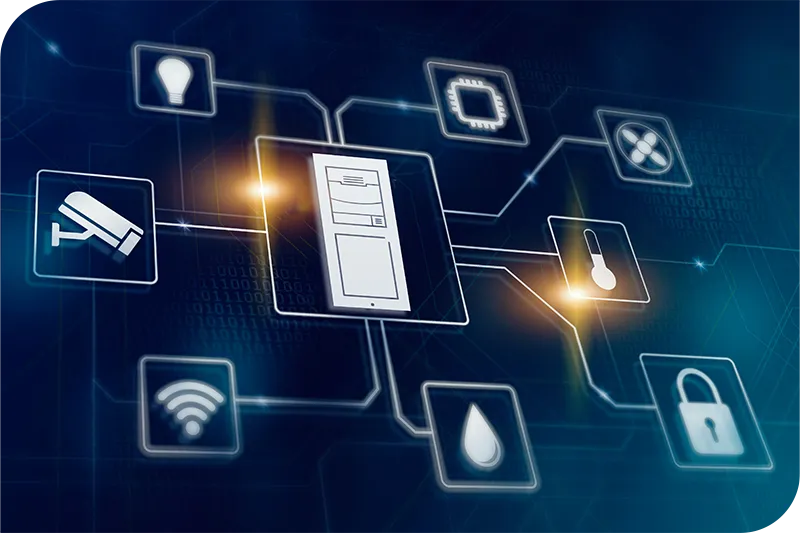The rise of automated smart home systems
 Camilla Ashdow, 31. 07. 2023 | 5 min read
Camilla Ashdow, 31. 07. 2023 | 5 min read
What should you know about automated smart home systems and how does IP access control fit into them?
Automated smart home systems: a new era of comfort
In recent years, the rise of home automation has revolutionized how we live, transforming ordinary homes into intelligent, interconnected spaces. Explore the history of this popular technology. Learn about current trends, top technologies, and resident preferences. Discover how IP intercoms, indoor stations, and access control readers seamlessly integrate into smart home systems.
Where did it all start?
Early Innovations (1920s - 1960s)
Automated smart home systems started in the early 1900s when people wanted to find ways to automate household chores. In the 1920s, inventors created the electric vacuum cleaner and automatic sprinkler systems, showcasing how automation could enhance home life.
The introduction of X-10 in the 1970s marked a significant milestone. X-10 allowed remote control of appliances and lighting in homes by using electrical wiring to transmit signals. This breakthrough technology laid the foundation for future developments in automated smart home systems.
The Rise of Automated Smart Home Systems (1980s - 2000s)
In the 1980s and 1990s, advancements in computing and networking technologies paved the way for the rise of smart homes. These systems allowed homeowners to control multiple functions, such as lighting, heating, and security, through centralized indoor stations or remote devices.
The emergence of microprocessors and the advent of the Internet in the 1990s brought about further advancements. Companies such as Crestron and HomeSeer introduced automated smart home systems that integrated multiple devices and provided sophisticated control interfaces.
The Internet of Things (IoT) Era (2010s - Present)
The 2010s marked a significant shift in automated smart home systems thanks to the invention of the Internet of Things (IoT).
Voice-activated virtual assistants like Amazon Alexa and Google Assistant changed how homeowners use smart devices. Voice control became a popular way to manage home automation systems, giving a hands-free and easy experience with endless possibilities.
What do residents want?
Always remember that someone will be using, and living with, the automated smart home system you install. Residents consider the following factors very important:
Ease of Use: User-friendly interfaces and intuitive controls are essential. Mobile apps with clear layouts and straightforward functionalities are highly preferred – no one wants to use something complex with bad design!
Customization: Everyone will value the ability to personalize their home automation systems according to their needs and preferences. Customizable settings for lighting, temperature, and security are key.
Integration and Compatibility: Residents look for systems that can work together as a whole, easy-to-use solution. Compatibility with open protocols allows for flexibility and scalability – which also ensures you won’t have to revisit the premises to install new technology every time the homeowner wants something new!
Security and Privacy: Given the sensitive nature of home automation systems, security and privacy are of utmost importance. Residents might not know what they’re looking for, but you should always ensure you install an automated smart home system that has robust encryption protocols and secure access controls to protect both their data and their homes.
Automated Smart Home Systems: Today’s Trends
There are some great trends today that homeowners would be proud to have in their smart home systems!
First things first – it’s worth mentioning that a key element to implementing any new technology is seamless integration! There is no use having a massive range of cutting-edge devices if nothing can communicate. When picking devices, consider a provider that supports open protocols and easy integration for a unified smart home experience.
Voice control
Homeowners can easily adjust lighting, play music, and control thermostats using voice control. They can do this by speaking just one sentence. Devices like Amazon Alexa enable this functionality. This isn’t just an emerging trend – it’s the new normal!
Energy Management
As our environmental consciousness grows, energy management in automated smart home systems has become a huge trend. Smart devices help homeowners save energy and money by controlling temperature, monitoring usage, and using efficient lighting.
Energy management can also include smart thermostats: amazing devices that learn residents' preferences and adjust temperature settings accordingly. Occupancy sensors can integrate with them to ensure they do not waste energy in rooms not being used.
Enhanced Security
Automated smart home systems can be integrated with other technology to provide advanced security features. Use IP intercoms, access control readers, surveillance cameras, and motion sensors as part of an entire solution that puts homeowners’ minds at ease. They will also appreciate mobile apps that allow them to monitor their homes from afar and get immediate alerts if anything suspicious happens.
Smart Lighting
A nice add-on to smart homes is the ability to ‘set the mood’ by controlling lighting. Residents can control wireless LED bulbs from a distance, adjust them, and program them for different lighting effects. The possibilities are endless! For the environmentally conscious, some systems can adjust lighting levels based on natural light, conserving energy.
 Stay up-to-date with the latest news. Subscribe to our newsletter.
Stay up-to-date with the latest news. Subscribe to our newsletter.
Understanding Access Control in the Context of Smart Homes
Adding access control to an automated smart home system allows homeowners to easily control who can enter their property. It also enables them to manage other smart devices in their homes.
Integration Possibilities and Benefits
IP intercoms let homeowners talk to visitors at the entrance and decide whether to let them in or not. Residents can control IP intercoms from a distance by connecting them to home automation systems. They can also access live video feeds from connected cameras.
Some IP intercoms can detect motion and noise. They can send alerts to the residents' security systems if something suspicious happens while they are away from home. These features make integrating automated smart home systems with IP intercoms vital in enhancing convenience and security.
Access control readers check people's identities and determine if they should be allowed in or not. They use predetermined access permissions such as mobile credentials, RFID cards, or PIN codes. Access control readers are commonly used to secure small areas such as tech rooms, pool rooms, or storage areas.
Integrating access control readers with automated smart home systems enables residents to control access to specific areas in their homes. These areas can include offices, wine cellars, or storage areas. Another useful part of the integration with access control readers is event detection: the devices can recognize when a door has been kicked in/tampered with and will then notify the security system.
Indoor stations, also called answering units, can be very powerful in terms of automated smart home systems. Installers usually place them at the front door and connect them to IP intercoms. This lets homeowners see video or hear audio and decide whether to let someone in or not.
Integrating indoor stations with home automation combines access control and smart home functions, putting everything in one central panel. Very convenient for residents!
Indoor stations with Android support have the possibility to install 3rd party home automation apps. People without Android-enabled indoor stations can still control lights, the lift, music, and the AC by sending HTTP commands.
Key Considerations for Installers and Integrators
Compatibility and Communication
Before integration, ensure that the access control system and the home automation system are compatible. They should be able to communicate with each other using common protocols. Thoroughly test the compatibility and communication between the systems to ensure seamless operation. Also, make sure you choose a reliable manufacturer that tests the compatibility itself and provides comprehensive and clear integration manuals.
Scalability and Flexibility
Think about how well the integrated solution can handle future expansions or changes in access control requirements. Homeowners' needs change often in today's fast-paced world. The system should be flexible enough to integrate additional access control components and adapt to evolving security needs.
Security and Encryption
Security is of paramount importance when integrating access control systems. Make sure that components encrypt data transmission and ensure that access control devices resist tampering and unauthorized manipulation. Regular firmware updates and adherence to industry security standards are essential.
User Training and Support
Provide comprehensive training to homeowners on how to operate the integrated access control and home automation system. Good documentation and support will help users use the solution well and fix any problems that come up.
To conclude
The rise of automated smart home systems marks a transformative shift in how we interact with and manage our living spaces. As technology continues to advance, these systems offer unparalleled convenience, efficiency, and security for homeowners. The advent of automated smart home systems presents a compelling and transformative technological leap, offering unmatched convenience and security. Understanding the role of IP access control within these systems, and installing devices from a good access control provider, allows homeowners to embrace a future where their homes are not only smarter but also safer, ushering in a new era of modern living.
